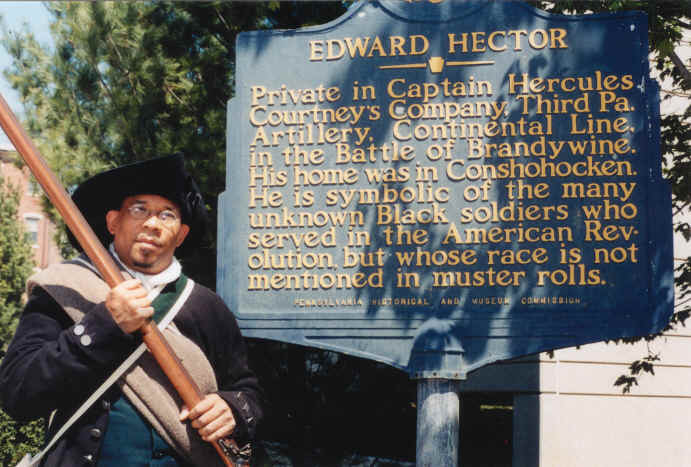
Pizza – Who Has the Best Update – Divisions breakdown
December 4, 2020
Did You take the Bench outside Capp’s Deli?
December 10, 2020Hector Street – Most Likely the 1st Street in America named after an African American

Hector Street – Most Likely the 1st Street in America named after an African American
by Brian Coll
12/4/2020
Edward “Ned” Hector.

Edward “Ned” Hector. If you google his name, or a portion of his name you might find yourself looking at a history of the American Revolutionary War. Ned was a soldier for the Continental Army. He was a private in Captain Hercules Courtney’s Company of Colonel Thomas Proctor’s 3rd Pennsylvania Artillery Regiment.
As a soldier he found himself fighting the British in Pennsylvania. He was listed at being involved in a battle in Germantown in October of 1777, and famously involved in the Battle of Brandywine. The Battle of Brandywine Creek took place on September 11th, 1777. It was the single longest day of fighting in all of the Revolutionary War. You can look up information about the battle itself, you will see American Heroes names in the roll call of the Battle including Marquis de Lafayette (which Fayette Street in Conshohocken is named after)
What brought Ned Hector, one of approximately 5,000 African American’s to fight in the Revolutionary War to fame if you will, was during the Battle of Brandywine. The Battle of Brandywine took place near John Chad’s house. John Chad’s house and his property was likely the reason for the name Chaddsford. During the Battle, Captain Hercules Courtney’s Company was outflanked and ordered to retreat. Defying the advancing soldiers, Edward “Ned” Hector rushed to save his wagon and munitions. He was a wagoneer and a bombardier who manned one of three rear positions of the cannon. He grabbed what weapons he could, loaded them into his wagon and made his retreat. As he rushed to save these needed munitions and weapons he was heard saying “The enemy shall not have my team; I will save my horses”
The munitions he saved helped the American forces continue the war and went into use at the Battle of Germantown.
After the war, Ned found himself in the Conshohocken area. At the time, it was just a village that took parts of Plymouth and Whitemarsh Townships. His cabin was near where Hector Street would be today, at the time it was part of a path called Barren Hill Road. Of course, we are going back into the 1780’s and Conshohocken is nowhere near what it is today. His cabin would have been in the woods. He hunted food for himself and his family. Ned Hector was the first African American to have settled in Conshohocken and become it’s first black resident.
January 3rd (we’ve also have seen the date as January 5th), 1834 at the age of 90, Edward Ned Hector passed away. During his internment, his wife of 50 years passed away.
Records show that in 1853, three years after Conshohocken became incorporated as a borough that Barren Hill Road (starting at the borough line), was cleared and widened and became formerly known as Hector Street. If you can picture life in America in the 1850’s, a decade before the American Civil War. For a small newly formed borough to dedicate a street in honor of an African American. At the time 32 borough residents, some of them very prominent including all of council, all 32 residents being white. For them to come together to honor this man, well it was something special. At first Burgess John Wood agreed to rename one block, and then as the project started it was determined to take up the length of the street through the borough. A bond was raised to do Hector Street and several other streets. Hector Street was part of the first major project by the young borough.
Naming Hector Street after Edward “Ned” Hector was unique at the time. It was so unique in fact, that we have yet to find any evidence that disputes that Hector Street, was in fact the first street in America named after an African American. This was nearly 20 years before African Americans were allowed to vote, (which is absurd) nearly 70 years before females were allowed to vote (which is absurd, and a whole other story). A number of the borough residents who signed the petition and urged council to name the street after Edward “Ned” Hector knew him while he lived here.
In a recent conversation with Noah Lewis, author of “Edward ‘Ned’ Hector – Revolutionary War Hero” he recently found evidence that while Hector Street officially became a street in 1853, there are references to Hector Street going back into the 1830’s. Noah saw Hector Street in a land deed dating back to the 1830’s in which it would have been common to call a road, a path or a street after the first person who lived there. Even in the 1830’s, he and his family wouldn’t have been the only residents. To have the street called Hector Street while he was living there also must have been a big deal.
I want to thank Mr. Noah Lewis, who has portrayed our American Revolutionary War Hero thoughout the area. He has brought Ned Hector to schools and libraries as well as community events for 20 years now. My dad Jack and myself have enjoyed our conversations with him over the years. We are grateful to him and his knowledge that he is always willing to share with us, as I now share it with you. Between my dad Jack, myself and Mr. Noah Lewis, none of us have been able to find anything to contradict the fact that the first street in America named after an African American is right here in Conshohocken. I am proud to walk on Hector Street and think of and thank Edward “Ned” Hector for being a hero all those years ago.
If you want to know more, I highly recommend checking out http://www.nedhector.com this is a website put together by Noah Lewis.
Thank you for reading.

